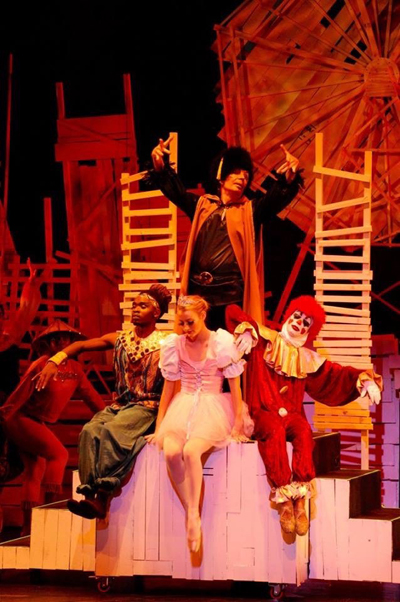MUSIC & DANCE: UNLV’S ‘PETRUSHKA’
By: Hal de Becker
In a program reminiscent of UNLV’s 2013 collaboration between its dance department and symphony orchestra, Ham Hall recently hosted the two entities in another performance of an early 20th century ballet set to the music of Igor Stravinsky: ‘Petrushka’.
Whereas UNLV’s 2013 ‘Rite of Spring’ was a totally new and different dance depiction, and a hugely successful one, Petrushka was described in the program notes as an “adaptation” of Michel Fokine’s 1911 ballet which is still performed in the original version by major dance companies.
UNLV’s production was enjoyable more for the excellent performances by its dancers, guest artists and 60 piece symphony orchestra under the baton of Taras Krysa, than for the adequate choreography by Dolly Kelepecz-Momot and Richard Havey.
Like the original, the adaptation was set at a Russian street fair circa 1830 where a bustling crowd in varied, multi-colored costumes mingled, performed and caroused while awaiting a puppet show.

Understandably the available forces for this semi-professional student production were limited and the ‘crowd’ was minimal and the costumes not only unvaried but dreary. Black is not a particularly festive color.
Juxtaposed to the real-life activity a dramatic fantasy played out in which three puppets, a self-centered Ballerina, a brutish Moor and the guileless Petrushka, all controlled by a Marionette Master, experienced some of the darker human feelings including jealousy, violence and unrequited love.
Petrushka loves the Ballerina but she prefers the powerful Moor and the violence that erupts between the two rivals proves fatal for Petrushka. In most productions his spirit survives to mock his oppressors, but in this one the ending was inconclusive.
Especially memorable, in addition to the music, were Alex Cancel in the title role and Anthony Rais as the Puppet Master.
Mr. Rais is indeed a real and renowned master of marionette manipulation and apparently a consummate actor as well. His portrayal of the mysterious Puppeteer was both menacing and compelling. His musicality, expressive hands and gestures, and strong stage presence were exceptional.

I was seated close enough to observe and appreciate his puppetry which included a tiny doll blowing up a balloon and the floating bones of a small skeleton. But I’ve been told that some patrons seated further back in the hall were unable to clearly see and enjoy those delightful, but often nuanced effects.
With loose limbed, seemingly boneless physicality Cancel was thoroughly convincing as the rag-doll puppet. Equally impressive, and perhaps even more challenging, was his ability to convey the character’s pathetic vulnerability and childlike innocence while maintaining its non-human identity.
Petrushka’s makeup was in itself a work of art with red wig and colorful facial designs. Costumes and makeup for both Petrushka and Puppeteer were created by Mr. Rais and were ideal for the roles.
Cosette Richardson, as Ballerina, was doll-like and dainty and, as befitting her role, danced on pointe. Lonnie Chaney III as Moor was appropriately lustful and aggressive.
Erika Vargus and Sara Crossman, an acro-dance duo, had a bag of tricks consisting of more than just the usual splits and cartwheels. They were accomplished tumblers and contortionists with a wide variety of flexible poses and aerial stunts. As well as portraying the Puppet Master’s decorative assistants their feats made a big contribution to the atmosphere of the street fair.
As townspeople and gypsy’s the dancers all performed with mature skill but it was the men who were particularly outstanding. Their partnering was secure and their technical accomplishments included clean leaps and turns.

Two additional, well danced works opened the program.
Riverrun by Louis Kavouras was a busy piece with lots of running and arm swinging to a score by the late Toru Takemitsu that did not seem to be dance-friendly.
In one appealing choreographic passage 12 small wooden blocks were lined diagonally across the darkened stage from corner to corner with each of eleven dancers curled up in the space between them. A lone figure walked over them, using the blocks as stepping stones as the dancers slowly unfolded their bodies with writhing serpentine movements.
April Wexelman’s Gymnopedies, set to two of the three familiar Erik Satie pieces, was predictable and lacked originality.
The program’s sculptural scenic design, by Dave Rowe, was a construct of wooden slats across the back of the stage with a large septilateral wheel at the center and flanked at each end by a tall tower. It had no direct connection to the three dances but with Peter Jakubowski’s imaginative lighting it made a fascinating presence for each of them.
The dance department’s next event “Choreographies” takes place at UNLV from November 19th to 21st with five evening and matinee performances. More info at 702-895-3827.


